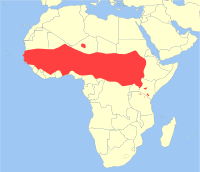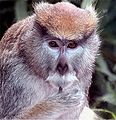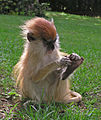- Patas monkey
-
Patas monkey[1] 
Conservation status Scientific classification Kingdom: Animalia Phylum: Chordata Class: Mammalia Order: Primates Family: Cercopithecidae Subfamily: Cercopithecinae Tribe: Cercopithecini Genus: Erythrocebus
Trouessart, 1897Species: E. patas Binomial name Erythrocebus patas
(Schreber, 1775)
Geographic range The patas monkey (Erythrocebus patas), also known as the Wadi monkey or Hussar monkey, is a ground-dwelling monkey distributed over semi-arid areas of West Africa, and into East Africa. It is the only species classified in the genus Erythrocebus. Recent phylogenetic evidence indicates that it is the closest relative of the vervet monkey (Cercopithecus aethiops), suggesting nomenclatural revision.
Contents
Appearance
The patas monkey grows to 85 cm (33 in) in length, excluding the tail, which measures 75 cm (30 in). Adult males are considerably larger than adult females. Reaching speeds of 55 km/h (34 mph), it is the fastest runner among the primates.[3]
Behavior
The patas monkey lives in multi-female groups of up to 60 individuals (although much larger aggregations have been reported). There is a weak dominance rank. The group contains just one adult male for most of the year.[4] During the breeding season, there are multi-male influxes into the group. Once juvenile males reach sexual maturity (around the age of 4 years old) they leave the group, usually joining all-male groups. The adult females in the group initiate movement of the group with the male following their lead.[4]
The patas monkey avoids dense woodlands and lives in more open savanna and semi-deserts. The patas monkey has a remarkably high reproductive rate, perhaps as an evolutionary response to the high adult mortality rates associated with this strongly terrestrial lifestyle.[5]
Diet
The patas monkey feeds on insects, gum, seeds, and tubers, a diet more characteristic of much smaller primates.[6]
Classification
There is some confusion surrounding the number of valid subspecies, with some listing four,[7] and others listing two; the western Erythrocebus patas patas (Common Patas; with a black nose) and the eastern Erythrocebus patas pyrrhonotus (Nisnas; with a white nose). Others, however, have suggested that at least some of the features used to separate these subspecies merely are variations in the female's facial pattern during pregnancy.[1] On the other hand, the change in the nose during pregnancy occurs only in the West African populations.
Additional images
Endnotes
- ^ a b Groves, C. (2005). Wilson, D. E., & Reeder, D. M, eds. ed. Mammal Species of the World (3rd ed.). Baltimore: Johns Hopkins University Press. pp. 160. OCLC 62265494. ISBN 0-801-88221-4. http://www.bucknell.edu/msw3/browse.asp?id=12100520.
- ^ Kingdon, J., Butynski, T. M. & De Jong, Y. (2008). Erythrocebus patas. In: IUCN 2008. IUCN Red List of Threatened Species. Downloaded on 4 January 2009.
- ^ Arsuaga & Ignacio 2006, p. 18
- ^ a b Hall 1965, pp. 15–87
- ^ Isbell et al. 2009, pp. 103–124
- ^ Isbell 1998, pp. 381–398
- ^ Kingdon 1997, pp. 57–58
References
- Arsuaga, Juan Luis; Ignacio, Martínez (2006) [1997]. The Chosen Species: The Long March of Human Evolution. Blackwell Publishing. ISBN 978-1-4051-1532-2.
- Hall, K. R. L. (July 8 1965). "Behaviour and ecology of the wild Patas monkey, Erythrocebus patas, in Uganda". Journal of Zoology (The Zoological Society of London) 148 (1). doi:10.1111/j.1469-7998.1966.tb02942.x.
- Kingdon, J. (1997). The Kingdon Guide to African Mammals. Academic Press Limited, London. ISBN 0-12-408355-2.
- Isbell, L.A. (1998). "Diet for a small primate: insectivory and gummivory in the (large) patas monkey (Erythrocebus patas)". American Journal of Primatology 45 (4). doi:10.1002/(SICI)1098-2345(1998)45:4<381::AID-AJP5>3.0.CO;2-S. PMID 9702283.
- Isbell, L.A., et al.; Young, TP; Jaffe, KE; Carlson, AA (2009). "Demography and life history of sympatric patas monkeys (Erythrocebus patas) and vervets (Cercopithecus aethiops) in Laikipia, Kenya.". International Journal of Primatology 30 (1): 103–124. doi:10.1007/s10764-009-9332-7. PMC 2949556. PMID 20976285. http://www.pubmedcentral.nih.gov/articlerender.fcgi?tool=pmcentrez&artid=2949556.
External links
Categories:- IUCN Red List least concern species
- Fauna of Burkina Faso
- Fauna of West Africa
- Mammals of Africa
- Megafauna of Africa
- Cercopithecine monkeys
- Monotypic mammal genera
- Animals described in 1775
Wikimedia Foundation. 2010.








